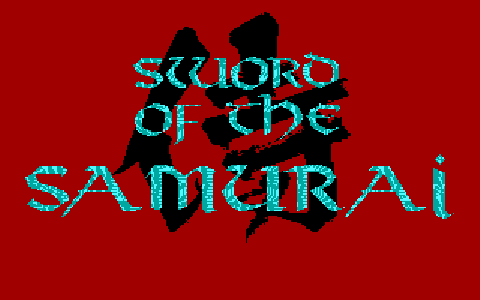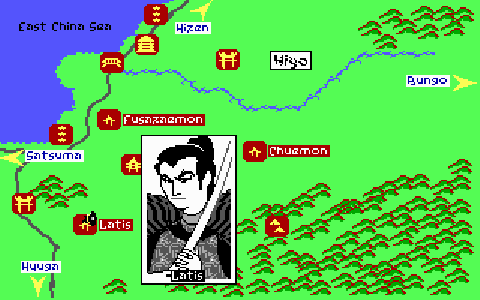Overview

Sword of the Samurai is a historical strategy adventure game developed and published by MicroProse for the PC (running DOS-based hardware) in 1989.
Similar to MicroProse's other strategy adventure games (such as Sid Meier's Covert Action and Sid Meier's Pirates!), the game shifts between an overall turn-based role-playing segment (where players control their general interactions) and numerous real-time mini-game segments.
Players control a lineage of lowly gokenin samurai in Feudal Japan, as they try to rise through the ranks of their clan by either amassing a strong army or committing honorable acts. Along the way, they must continue their lineage (by courting wives to bear children) and keep their political rivals in check (sometimes through espionage, such as kidnapping, treachery, and assassination).
The game was later digitally re-released in 2014 by Retroism and Nightdive for modern PC, Mac, and Linux systems on Steam and GOG.com. Like most digital re-releases of DOS games, it uses DOSBox emulation.
Game Phases
 The Samurai and Hatamoto phases require a lengthy travel sequence with random encounters.
The Samurai and Hatamoto phases require a lengthy travel sequence with random encounters.The main game is split up into three phases: Samurai, Hatamoto, and Daimyo. Each phase determines the size of the player's army and who leads them. The end goal of the game is for the player's daimyo to successfully become warlord (shogun) of all Japan.
- Samurai - In the earliest phase of the game, players hold only a small fief and control only a small band of soldiers. They are led by a lieutenant (hatamoto) of the clan and must be in the best favor of the clan's lord (daimyo) to be named the successor (once the hatamoto dies or retires).
- Hatamoto - When the player's samurai succeeds their hatamoto, they control a much larger fief, and thus control a bigger army. While the gameplay is identical to the previous phase, some aspects of the game are more difficult (including longer distances to travel and rival castles with multiple floors). They are led by the clan's daimyo, and can become the successor either by usurping the current daimyo by force (a risky maneuver which involves success of all three action sequences) or by declaring themselves daimyo once the old one dies or retires (which can be contested by rival hatamotos, sometimes requiring a strategic battle).
- Daimyo - In the game's final phase, players now control whole provinces with a very large army. Unlike the other phases, the province map for on-foot traveling is replaced by a strategic map of all Japan. Players can now conquer other territories (contested or not) and have no higher authority to serve (allowing them to commit treacherous acts without being forced to commit seppuku). To reach the endgame, players must conquer at least 24 provinces (one of them required to be Omi) and win one final strategic battle against an alliance of all rival daimyos.
One the player conquers all of Japan as shogun, they are given an epilogue and final score determining the success of their shogunate. This score is determined by the player's current stats, game difficulty, whether they have a heir, and the size of their rival armies. Epilogues range from an immediate overthrow to centuries of peaceful rule.
Mini-Games
- Dueling - A one on one sword fight. Players are able to block and swing a sword in various directions, in addition to moving about a small play area. It comes in several scenarios, including training, killing cornered assassinations, or even duels from wandering swordsmen. Failure can often lead to death. Victory grants honor.
- Melee - Viewed from overhead, players are confronted with a multitude of enemies they must defeat. Like dueling, it comes in a variety of differing scenarios, such as infiltrating mountain bandit bases to save damsels in distress, sneaking into a rivals castle to assassinate him, or defending a village from bandit attack. Victory can grant honor, or in the damsel in distress case, a bride.
- Battle - A strategy mini-game viewed from an overhead perspective. Players are either on the offensive, or the defensive, and can pick from a few different formations and approaches to begin with. The player's army starts off as pure infantry, more varied troop types become available as the player's troop count grows. Eventually players will control archers, horsemen, and arquebuses (very early pre-musket guns). The attacking side always marches towards the defending side, and the side that either eliminates or routes the enemy wins. Victory often grants more territory, and thus a larger army.
Log in to comment